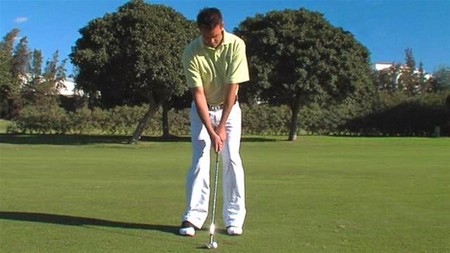An accurate approach shot can save at least one putt per hole, so it is well worth your while improving this part of your game. When you practice your pitching, be sure to write down the results in your notebook for reference when you are playing.
It is very important to get a clear mental picture of trajectory and flight for each type of pitch shot you play; therefore, practice only one type of pitch shot per session, so as not to confuse things.
Most changes that you can make to the flight and trajectory of the shot can be made at address, because the address position affects the shape, length and even the speed of the swing.
The waggle
As with all shots played in golf, the swing movement is instigated by a forward press. As the distance you want the ball to travel increases, a waggle or two prior to placing the club head behind the ball will help. The waggle (a preparatory mini-movement of the club head away from the ball) is made by flexing the left forearm and wrist to ensure that the backswing starts in the same manner. In other words, the waggle ‘programs’ you to start the backswing with the left arm moving the club head smoothly back, not by the right hand/arm pulling it away from the ball – this would alter the position of the club face as well as the swing line.
The waggles should keep the same tempo as the desired swing – sharp and direct when playing a short, distinct pitch over a bunker, but much slower and longer when preparing to play a soft, high pitch.
A final word of advice on pitching. Because the pitch shot is more intricate than the one-lever chip, never pitch when you can chip.
The pitching routine
Before playing the shot, imagine the trajectory, the landing point and the bounce and roll of the ball. Then take your practice swings in order to add ‘feel’.
Make sure that the address position is correct for the type of pitch that you are about to play, and then swing the club, letting it do the work; on no account try to help the ball into the air – all that is needed are the correct stance and posture, together with a repeat of your practice swing.
When you play a high or normal pitch shot (slow or normal swing speed), the club should be swung freely, even at the slower speed, allowing the legs and hips to move in unison with the arms. The short-shafted address produces the more upright swing that is essential to good short-iron play around the green.
It is easier to judge the distance the ball will travel by the amount of swing movement rather than by club-head speed at impact. The best way to balance the length of the backswing with the length of the follow through is by the clock method. If you swing the arms on the backswing to nine o’clock, then your follow through should leave them in the three o’clock position. Similarly, a ten o’clock backswing should produce a two o’clock finish position.
Practicing Pitching drills
- Practice this shot with your feet together. This will give you an idea of the length of flight you can expect from different lengths of swing, without using the body. Any use of the upper body while you have the feet together will change the swing path radically, causing you to mishit the ball.
- Starting with a swing speed that is less than your normal speed, let go of the club with your right hand as you finish the swing. Repeat this several times, each time releasing the right hand earlier, until you are doing this just after the strike.
- Repeat the sequence in step 2 above, only now your swing should have its normal speed. Release your right hand late in the follow through and then work back to release just after impact.
This drill is excellent for improving left-arm control of your swing, ensuring that the path of the swing is towards the target at impact. It may even help you to accomplish a slight draw, which is an important part of ball control and will prove very valuable later on in your golfing career.
Categories
Advertisements
Recent Articles
 How to Understand Bed Sizes – A Small Guide
How to Understand Bed Sizes – A Small Guide How to Select Some Must Have Kitchen Accessories
How to Select Some Must Have Kitchen Accessories Best Way to Change a Car Tire
Best Way to Change a Car Tire Best Way to Write an Affirmation
Best Way to Write an Affirmation Best Way to Take Charge of Your Financial Life
Best Way to Take Charge of Your Financial Life Best Way to Survive a Party When You Don’t Know Anyone
Best Way to Survive a Party When You Don’t Know Anyone Best Way to Stop Self Sabotaging Yourself
Best Way to Stop Self Sabotaging Yourself Best Way to Start Journal Writing
Best Way to Start Journal Writing Best Way to Speak with a Powerful Voice
Best Way to Speak with a Powerful Voice Best Way to Simplify Your Life
Best Way to Simplify Your Life Best Way to Respond to a Put-Down
Best Way to Respond to a Put-Down Best Way to Reduce Acne Breakouts
Best Way to Reduce Acne Breakouts Best Way to Recover from Dining Disasters
Best Way to Recover from Dining Disasters Best Way to Quit Your Job Gracefully
Best Way to Quit Your Job Gracefully Best Way to Make Your Own Website
Best Way to Make Your Own Website



Leave a Reply